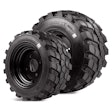Caterpillar Inc. announces the introduction of the new Production-Class vibratory soil compactors. The Production-Class range of vibratory soil compactors includes 11 models that feature the industry-proven productivity and reliability that have made the previous E-Series the preferred choice of earthmoving contractors worldwide. There are many new features and improvements that make the new Production-Class even more productive, reliable and durable.
The range of vibratory soil compactors includes the smooth drum CS54, CS56, CS64, CS74, CS76 and CS76 XT. Padfoot models include the CP54 (not offered in North America), CP56, CP64, CP74, and CP76. Production-Class soil compactors have operating weights ranging from 10.5 – 19 metric tons (11.6 – 21 U.S. tons) and feature the exclusive Cat® dual pump propel system that provides excellent gradeability and blade performance. The dual pump propel system provides separate hydraulic flow to the rear wheels and the drum for exceptional tractive effort in soft underfoot conditions or steep slope applications and allows for superior control on a grade in forward and reverse.
The biggest changes improve productivity and reliability. The new models feature a new engine that offers improved efficiency, better serviceability, more power, less noise and lower emissions. There are a number of options available as well, including AccuGrade® Compaction, an intelligent compaction solution that correlates compaction measurements with GPS positions to create detailed compaction maps of the work area.
A Model to Suit Any Application
|
Smooth Drum Models
Operating Weight (with ROPS/FOPS cab and AC) |
Padfoot Drum Models
Operating Weight (with ROPS/FOPS cab and AC) |
||||||
|
CS54
|
10 840 kg
|
23,898 lb
|
CP54
|
11 530 kg
|
25,419 lb
|
||
|
CS56
|
11 741 kg
|
25,885 lb
|
CP56
|
11 687 kg
|
25,765 lb
|
||
|
CS64
|
14 470 kg
|
31,901 lb
|
CP64
|
14 543 kg
|
32,062 lb
|
||
|
CS74
|
15 687 kg
|
34,584 lb
|
CP74
|
15 565 kg
|
34,315 lb
|
||
|
CS76
|
16 990 kg
|
37,457 lb
|
CP76
|
17 127 kg
|
37,759 lb
|
||
|
CS76 XT
|
18 843 kg
|
41,542 lb
|
|
|
|
||
The new C4.4 and C6.6 engines feature a thicker engine block and more-robust components. This improved design makes the engines more reliable and helps them run more quietly. An improved engine airflow design vents engine heat at the rear of the machine. The design helps prevent exhaust from blowing ground-level debris, or blowing heat on the operator.
High tractive effort, especially useful on steep slopes and thick lifts, helps increase production and expands the application range for Production-Class models. The dual pump system provides separate balanced flow to the rear axle motor and drum drive motor. This system provides superior tractive effort in both forward and reverse operation. The rear axle also incorporates a limited slip differential for smooth and quiet torque transfer.
The operator’s station is spacious and comfortable. An adjustable steering column enables the operator to position the steering wheel to a desired position. The optional leveling blade is controlled by the operator’s right foot to provide simple operation of machine propel, steer and blade functions simultaneously.
A bolt-on ROPS/FOPS canopy or a ROPS/FOPS cab is available. Low noise levels both at the operator’s station and at ground level allow greater operator comfort and less noise emitted to the surrounding environment.
Excellent operator visibility and easy service access are provided by an improved rear hood design. The sloped hood delivers enhanced visibility to the sides of the machine, and allows the operator to see obstacles measuring 1 meter (3″ 3″) high and 1 meter (3″ 3″) to the rear of the machine. The cab option now features more rear cab glass for greater visibility to the rear of the machine.
Production-Class soil compactors use the patented Cat eccentric weight system with two pod-style weight housings inside the drum. Vibratory system service is much easier with the pod-style design. The pod can be exchanged while the drum stays horizontal. Simply remove the old pod and replace it with a new one.
Because of the decreased risk of contamination and the use of synthetic oil, the change interval for the bearing lubrication oil is 3 years/3000 hours, and oil sampling on the vibratory system is no longer required.
AccuGrade Compaction GPS Mapping and Measurement is available as an option on the CS56, CS64, CS74, CS76 and CS76 XT. The system assists the operator in determining the compaction level of a material and maps the results using AccuGrade GPS mapping systems. The system includes a backlit display, GPS receiver and mast, radio transponder, processor, sensors, and cables. AccuGrade Office software is available as an option. This software makes it easy to use the data collected by the AccuGrade Compaction system.
A compactor equipped with the AccuGrade Compaction system can record compaction measurements and correlate them with a 3-dimensional job plan, providing a proof rolling record for every square foot (meter) of the project. This is significant, considering that testing costs and time requirements make it difficult to perform more than one quality test for every 100,000 square feet (9290 square meters). The ability to generate these proof rolls as the machine works provides economy of time and alerts the operator to trouble spots that may require immediate rework.
This capability allows the compactor to determine the suitability of the job produced by the contractor (Quality Control, or “QC”), and provides the project owner with documentation on a one-to-one testing basis (Quality Assurance, or “QA”)
A number of options are available that enhance the productivity and versatility of the Production-Class soil compactors, or provide increased operator comfort.
Service access is simple and convenient on the Production-Class compactors. All routine service is conducted from the right side of the machine. The durable one-piece fiberglass hood tilts forward quickly and easily for exceptional access to the engine and cooling system.
Other features that make servicing these machines simple include leak-resistant O-ring face seal hydraulic fittings, pressure test ports, S·O·S SM valves and ecology drains.
The hydraulic oil service interval has been increased to 2 years/2,000 hours. This will provide lower owning and operating costs, as well as increase productivity due to less machine downtime.
Hydraulic hoses are held securely in place with polyurethane routing blocks. The blocks separate hoses helping ensure that they do not rub on one another.
Nylon-braided wire harnesses protect the 24-volt electrical system, and all wires are color-coded and numbered for greater serviceability. All-weather connectors are used to ensure high system reliability.
The oil cooler is also hinged at the bottom to allow it to be tilted away from the radiator to improve access and cleaning.
The Production-Class vibratory soil compactors have been designed to comply with applicable OSHA regulations.











